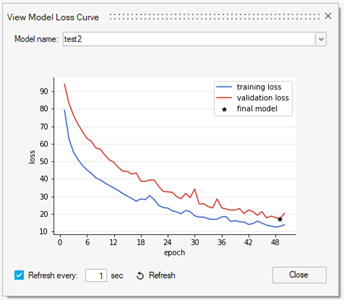Altair physicsAI 2023.1 Release Notes
New Features
- Visualize Training Results More Easily
- Training and validation losses are important metrics to assess the
progress of the machine learning training process. The new Model Loss
Curve presents these metrics visually in a chart. These charts make it
easier to interpret physicsAI trainings.

Figure 1. - Continue Training Without Starting from Scratch
- The physicsAI training process can take time and having to start over fresh can feel like a waste of time. The restart functionality enables the training process to pick up where it left off. This transfer-learning based technology saves you time whether adding more data to your training sets or re-initiating a prematurely converged process.
- Predict a Broader Range of Engineering Results
- Not all simulations are 3d fields, such as CFD pressure or structural displacement. Scalar numbers or time history curves can be predicted. PhysicsAI can now be applied to a broader set of design problems that include things like CFD drag or structural contact force.
- Access Scalable Computing Resources with Seamless Integration to Altair One
- Geometric deep learning requires substantial computing resources for training. Altair One provides workflows to train physicsAI models. Access to the computing power you need is easy with Altair One’s scalable HPC and cloud resources.
Enhancements
- Reduced time for inference/prediction.
- Recommended upper limit on mesh size substantially increased from 0.5 million nodes to approximately an order of magnitude larger.